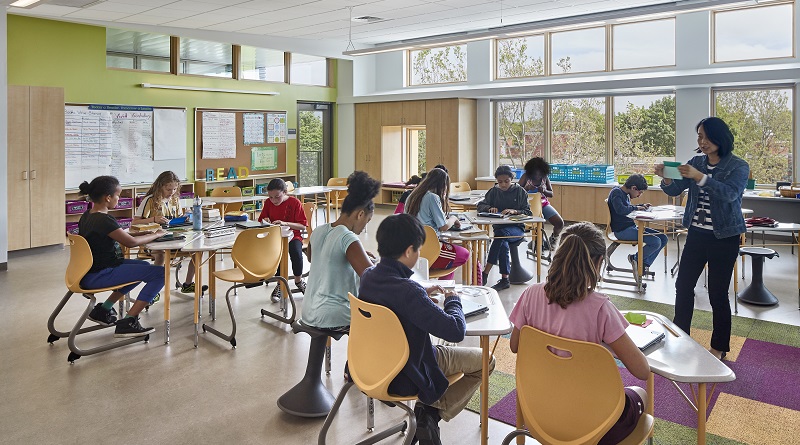Perkins Eastman-Designed School Earns LEED Platinum
By Roxanne Squires
CAMBRIDGE, Mass. — International design and architecture firm Perkins Eastman recently announced that Dr. Martin Luther King, Jr. School in Cambridge has been certified LEED Platinum.
The 170,000-square-foot school achieved 89 points out of 110 base points possible for LEED — making it the second highest-scoring new school in the world certified under USGBC’s LEED for Schools-New Construction system, according to a press release.
Sean O’Donnell FAIA, LEED AP, Principal-in-Charge of the project and Perkins Eastman’s practice area leader for K-12 education, said that both Dr. Martin Luther King, Jr. and Dunbar High School scored so highly on the LEED Platinum scale for the same reason — all of the stakeholders were committed to the vision of creating the most sustainable, highest-performance learning environments possible.
“The integrated design process with these stakeholders assured that strategies were researched and vetted in a cross-disciplinary way which made the projects successful in the full spectrum of LEED categories, said O’Donnell. “Accordingly, many opportunities and systems were optimized and integrated into the designs to achieve this level of performance.”
These ranged from proper massing and solar orientation with systems to conserve resources. These resources included the ground source heat pumps for heating and cooling, the on-demand dedicated outdoor air ventilation, extensive photo-voltaic systems, the graywater system for flushing toilets, the building envelope and light shelves to those that enhance Indoor Environmental Quality such as lighting, acoustics, as well as healthy materials, and elements that transformed what would otherwise be concealed infrastructure into opportunities.
“Most importantly, these strategies were utilized to create light-filled spaces that are quiet, comfortable, flexible, and beautiful – spaces where students and teachers can collaborate together or focus individually,” said O’Donnell.
Jana Silsby AIA, LEED AP, the project’s senior designer explained the process was different from other they have worked on, in both feasibility and schematic design phases.
“A great deal of effort went into understanding exactly how the building would be maintained and used, right down to detailed plug load information, in order to provide the best and most affordable design possible,” said Silsby. “Energy modeling and analysis was used from the beginning to inform design decisions, including an embodied carbon analysis to help determine whether to renovate the existing building or build new. While we always focus on optimizing daylight and views in the learning environment, this was the first project that we could digitally model these attributes and fine-tune the design in near real-time.”
Therefore, the classrooms are suffused with plentiful natural light and as a result are among the most beautiful that we have ever designed. Teachers evidently agree, as virtually every time we visit the building we find that they have opted to leave the lights off, preferring to enjoy the daylight.
“The Dr. Martin Luther King, Jr. School sets a high bar for quality and environmental responsibility by achieving LEED Platinum,” said Anisa Heming, director of the Center for Green Schools at the U.S. Green Building Council. “Any visitor to the school can tell the care and commitment that went into its design and construction, made visible by its rooftop garden, welcoming auditorium, public art, and daylit classrooms. We commend Cambridge Public Schools, Perkins Eastman, and all of their partners for bringing this healthy, inspiring learning environment to students and delivering a school the students, parents, and teachers can be proud of.”

